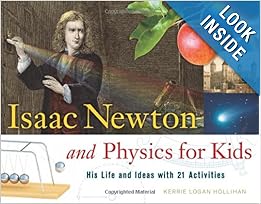
Isaac Newton was as strange as he was intelligent. In a few short years, he made astounding discoveries in physics, astronomy, optics, and mathematics— yet never told a soul. Though isolated, snobbish, and jealous, he almost single-handedly changed the course of scientific advancement and ushered in the Enlightenment. Newton invented the refracting telescope, explained the motion of planets and comets, discovered the multicolored nature of light, and created an entirely new field of mathematical understanding: calculus. The world might have been a very different place had Netwon’s theories and observations not been coaxed out of him by his colleagues.
Isaac Newton and Physics for Kids paints a rich portrait of this
brilliant and complex man, including 21 hands-on projects that explore the
scientific concepts Newton developed and the times in which he lived. Readers
will build a simple waterwheel, create a 17thcentury plague mask, track the
phases of the moon, and test Newton’s Three Laws of Motion using coins, a
skateboard, and a model boat they construct themselves. The text includes a time
line, online resources, and reading list for further study. And through it all,
readers will learn how the son of a Woolsthorpe sheep farmer grew to become the
most influential physicist in history.
From School Library Journal
Grade 4–7—An opening time line commences
with the 1642 marriage of Newton's parents and closes with his death in 1727,
and a general introduction describes the man and the times in which he lived.
The text touches on Newton's childhood in Woolsthorpe, his studies at Cambridge,
which led to his three laws of motion, and his time as master of the Royal Mint
and president of the Royal Society. The activities elucidate, for example,
concepts in mathematics ("What Are the Odds?") and physics ("Create Optical
Illusions"), and reveal more historical details. For example, in a section on
the 17th-century plague, readers are provided with instructions on how to make a
mask like those worn by doctors of the time. The activities will generally not
be suitable for science fairs, but are likely to engage readers. Lengthy
sidebars provide additional information about pertinent subjects ("Comets,"
"Churches, Kings, and Freedom of Speech") as well as individuals and events that
influenced Newton's work. The writing is clear and detailed, but is best suited
for motivated readers. Black-and-white illustrations on every spread consist
primarily of reproductions of art and of scientific diagrams. Some of the
further-reading suggestions, including two tiles by Newton, are for adults. This
will be a handy supplement to a physics curriculum and would be a useful
selection for school and public libraries.—Maren Ostergard, King County
Library System, Issaquah, WA
댓글 없음:
댓글 쓰기